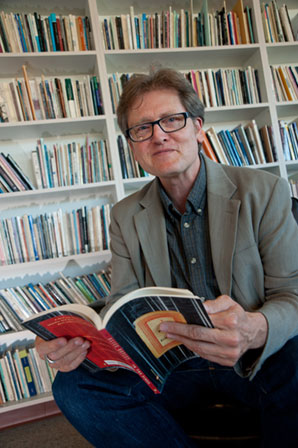by Jesse Hamlin
SF State is home to one of the most extensive collections of literary recordings in the United States, and now you don't have to visit campus to enjoy them.

Executive Director Steve Dickison curates the Poetry Center's extensive public reading series. Photo by Gino de Grandis.
Steve Dickison sits at his computer in SF State's renowned Poetry Center on a drizzly October morning, listening to a lively recording of Allen Ginsberg reading "Wrote This Last Night" for a big crowd on campus in 1959.
Ginsberg, who had performed his epochal "Howl" the night before at a Poetry Center reading at Fugazi Hall in North Beach, spins out a stream of surreal and comic images that tell "the tale of the sensitive car who was tossed up from the earth in Pittsburgh/She screamed like a Swedish prime minister on her first flight down the red neon highway." You can tell from the energy and laughter in the recording that both poet and audience were enjoying themselves.
"He has a measure of the vaudevillian in him. It's almost like a Lenny Bruce improvisation, the way he captures the play of the mind," says Dickison, the longtime executive director of the Poetry Center and its American Poetry Archives, a treasure trove of audio and video recordings of writers that comprises one of the greatest literary collections in the country. Ginsberg's 1959 recording -- which also features the poet reciting his incantatory "Kaddish" and conveys a sense of liberation from the repressive culture of the period -- is one of 50 analog tapes from the 1950s that have

From top: Robert Duncan,Gary Snyder, Patricia Parker and George Oppen. Photo by Christa Fleischmann.
been digitized and made available on the new Poetry Center Digital Archive. Nearly a decade in the works, the archive went online in April. It recently featured two videos of Swedish poet Tomas Tranströmer, winner of this year's Nobel Prize in Literature, reading at SF State in 1974 and 1982.
Over the coming months, the Poetry Center staff will add another 40 or so historic recordings from the '50s, put up dozens from the '60s and begin posting the videos the center began taping in 1973. Eventually, the digital archive will contain a large portion of the 4,000 hours of recordings the center has made since it began in 1954.

From top: Lawrence Ferlinghetti, Bob Kaufman, Daniel Moore and Madeline Gleason. Photo by Christa Fleischmann.
Founded by English Professor Ruth Witt-Diamant with a $200 donation from W.H. Auden, the Poetry Center has presented and recorded an astonishing range of writers during the last half century. They include such celebrated and influential poets and novelists as Gary Snyder, Robert Lowell, James Baldwin, John Ashbery, Doris Lessing, Octavio Paz and Alice Walker as well as William Carlos Williams, Marianne Moore and Langston Hughes -- all of whose first West Coast readings were arranged by Witt-Diamant in the 1950s.
In the past, the Archives' reel-to-reel magnetic tapes, stored in a climate-controlled room in the Humanities building, were used primarily for teaching and research purposes. The center sold and rented vhs tapes. Now, digitized and posted online, the recordings are available to everyone for free.
"Anyone who's interested in poetry or curious about what poetry might be can access it through this archive," says Dickison, also a poet and SF State Creative Writing lecturer.
Hearing writers read their own work enriches one's sense of the poem and the poet. That's why Dickison and other faculty often play recordings from the archives for their students. "There's an intimacy to the recording that you don't necessarily get when you read the poem in a book," says Dickison, who teaches the course "Beat Writers in the Archives."The poet talks directly to you."
Before he joined the Creative Writing faculty at SF State in 2003, poet Paul Hoover taught at Columbia College in Chicago, where he was given $3,000 to beef up their poetry program. He spent it all on videotapes from the SF State Poetry Center archives. He wanted his students to see and hear writers like Amiri Baraka and Charles Olson.
"For students, it can be a breakthrough in understanding," says Hoover, who uses archival recordings in his classes. "It brings the poet near. When they hear the timbre of the voice and the live cadences, it awakens the work on the page for them."
Dickison has had the pleasure of going back and listening to many of the one-of-a-kind recordings that Poetry Center Videographer and Archives Manager Jiri Veskrna has been digitizing with the help of students. They play the old analog tapes on a classic Nagra reel-to-reel recorder, which is connected to a converter box that's in turn connected to the computer. Using Pro Tools software, the recordings are processed into mp3 files.
Dickison says he was moved by a 1959 recording of Robert Duncan, the erudite and influential poet who was the center's assistant director at the time. Duncan not only read from his forthcoming book, "The Opening of the Field," but also discussed its creation.
"He tells the traces of how he gets to the work, which is fascinating. That doesn't really exist except on tape. You get context, and you get the mind at work, outside of the artwork."